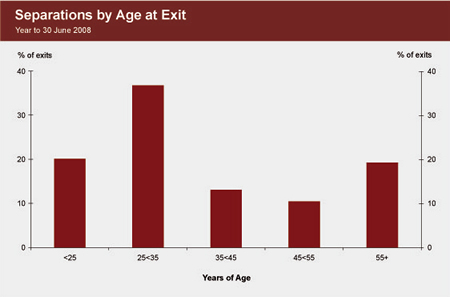Equity & Diversity Annual Report – 2008 Section 3: Human Resource Policies & Practices
Section 3.1: Recruitment & Selection
The RBA's recruitment policies and guidelines highlight the importance of equity and diversity principles in the selection of staff. The RBA continues to attract high-quality external candidates at all levels including to its graduate and entry-level programs. The RBA uses a range of merit-based recruitment strategies to attract a diverse range of applicants including from groups under-represented in the RBA.
The RBA's selection processes are continually under review to ensure compliance with anti-discrimination legislation. The RBA's training of selection panel members is conducted by subject-matter experts and highlights equity and diversity principles and anti-discrimination issues.
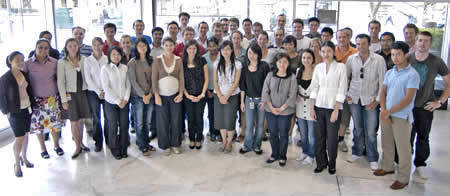
The Graduate Development Program continues to attract qualified women into professional positions. The graduate intake for 2008 saw the largest proportion of female graduates entering the RBA for some time, at 45 per cent of the total intake. The RBA's involvement with the Australian Association of Graduate Employers and participation in the annual Australasian Graduate Recruitment Benchmarking Survey ensures that the RBA is well informed on best practice initiatives in graduate recruitment.
| Year | Women | Men | Total | Ratio |
|---|---|---|---|---|
| 2008 | 24 | 29 | 53 | 45:55 |
| 2007 | 11 | 30 | 41 | 27:73 |
| 2006 | 11 | 26 | 37 | 30:70 |
| 2005 | 15 | 25 | 40 | 38:63 |
| 2004 | 8 | 21 | 29 | 28:72 |
| 2003 | 8 | 26 | 34 | 24:76 |
| 2002* | 14 | 25 | 39 | 36:64 |
| 2001 | 7 | 26 | 33 | 21:79 |
| 2000 | 14 | 20 | 34 | 41:59 |
| *The 2002 figure includes 4 graduates that did not participate in the Graduate Development Program (2 males, 2 females) | ||||
Online recruitment is the most prominent medium used to attract new employees; all RBA vacancies are advertised on the RBA's own web site and on a number of prominent online job boards. Candidates for the RBA's Traineeship Program are sourced through TAFE colleges, high schools, job boards and specialist employment agencies representing people with disabilities and indigenous Australians. Increasingly, the RBA is assessing job applicants for suitability in jobs other than those that they had originally applied for.
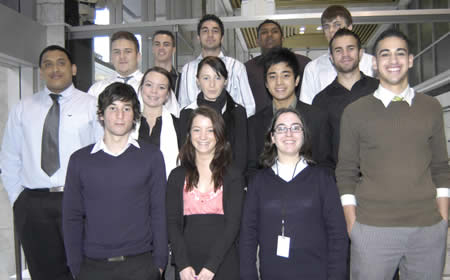
The RBA seeks to employ indigenous Australians and people with disabilities to designated traineeship positions each year. In the coming year the RBA will examine indigenous recruitment programs and scholarships. The RBA will also investigate avenues to promote High School work experience programs to students with disabilities and indigenous Australians.
Section 3.2: Learning & Development
Equity and diversity issues are incorporated into learning and development programs provided by the RBA. In 2007, the RBA's training programs and practices were reviewed to ensure that they met the diversity needs of staff.
A number of programs addressing diversity and cultural awareness were implemented during 2007/08. A workshop on equity and diversity was developed for non-managerial staff as part of the Skills Development Certificate. The RBA also offers English language skills training for staff from a non-English speaking background, primarily writing and grammar coaching over a number of months. The RBA consulted with its indigenous staff on methods of increasing awareness of indigenous issues during NAIDOC week. The RBA's Aboriginal artwork was displayed in the Museum of Australian Currency Notes and an awareness session was held for the RBA's Diversity Contact Managers.
The RBA monitors women's access to, and participation in, training activities. The RBA continues to support Springboard, an external professional development program for non-managerial women, with seven women attending in 2007/08. A similar program, Top Steps, was successfully piloted and is now part of the RBA's equity program. Two external programs were offered to women in management in 2007/08: Xplore Career Resilience and Professional Steps. These programs aim to assist women to develop leadership skills and build strong senior support networks. Women in management were also invited to a series of external events which involved opportunities to hear speakers present on leadership topics and to network with women from other organisations.
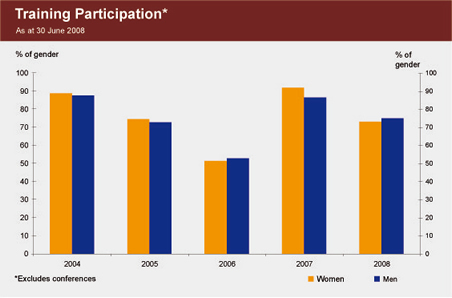
As part of an ongoing awareness program, the RBA has undertaken a number of accessibility initiatives. In this reporting period, most of these initiatives related to accessibility of computing-related systems and information, and included: the purchase of an online accessibility training package which was made available to all staff; demonstrations for staff of the various accessibility tools used by the RBA; general awareness workshops on accessibility and electronic documents; and making the RBA's core online training modules available in alternative formats.
Graduate Development Program
The two-year Graduate Development Program continues to provide extensive training and development opportunities as well as a strong foundation for longer term professional development. Fifty-three graduates, predominantly with Honours degrees, joined the 2008 program. Graduates on the Development Program, like all new RBA employees, receive training in equity and diversity as part of the induction process.
Management Programs
The RBA supports a range of management programs for its staff. Each year, the RBA runs its Central Banking Management Program for newly promoted managers. This program seeks to foster the leadership skills of these managers, while also enhancing their understanding of the RBA's operations, policies and practices, including on equity and diversity matters. The program also provides participants with the opportunity to have direct input into current strategic issues relating to the RBA. The program this year was attended by a total of 15 staff (9 men, 6 women).

Thirteen staff (9 men, 4 women) took part in the New Managers Program, which is targeted at staff progressing towards management. It is designed to provide participants with an understanding of the characteristics of effective leadership, team building and management, effective conflict management, and equity and diversity management.
Section 3.3: Staff Mobility: Promotions, Transfers, & Secondments
Promotions, transfers and rotations within the RBA, including to overseas and regional offices, are an important means of staff development. Staff are also provided with opportunities to act in higher positions and to undertake secondments to other institutions. Over the past year, staff have worked at the following organisations – the Bank for International Settlements, the International Monetary Fund, the Bank of France, the Australian Prudential Regulation Authority, and the Australian Securities and Investments Commission.
The RBA has a number of policies and processes in place to ensure the provision of a fair and equitable method of assessment for promotion and transfer and to remove possible barriers to career mobility. These policies require that:
- equity and diversity principles are incorporated in the guidelines;
- both genders are represented on selection panels, where practicable;
- training for selection panel members includes information on their equity responsibilities;
- job-evaluation mechanisms are centralised;
- the criteria for assessing merit are well established;
- part-time staff are eligible to apply for promotion; and
- staff on parental leave can apply for vacant positions.
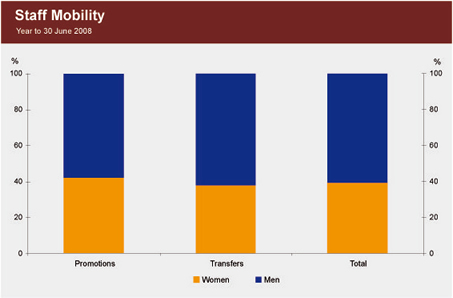
Internal mobility rates for staff continue to be monitored across all equity groups. Female staff accounted for 38 per cent of all staff transfers and 42 per cent of all promotions, comparable to the overall share of female staff at 42 per cent. Sixteen per cent of women were transferred in 2007/08.
The RBA's Business Resumption Site (BRS), which became fully operational in July 2007, was built to provide comprehensive back-up for critical RBA operations. An Intranet site was developed to provide staffing information on transport links, childcare centres in the vicinity and relief arrangements. A survey of staff working at the BRS suggested a high level of staff satisfaction with work/life balance.
Section 3.4: Remuneration
The RBA has developed a merit-based remuneration system that discourages any policies or practices that may lead to wage discrimination on the grounds of gender. The RBA's remuneration system has two key features designed to promote pay equity. First, all jobs are regularly evaluated to ensure that they are appropriately remunerated. This is done by comparing remuneration rates for a particular job to that of similar jobs both within the RBA and externally. Second, pay increases for contract staff are determined with reference to an annual skills and performance review; staff covered by the Enterprise Agreement receive a pre-determined wage increase negotiated between the RBA and the union.
Pay distribution within the RBA continues to be monitored. An analysis of salaries of all staff, irrespective of whether staff are on an individual employment contract or are covered by the RBA's Enterprise Agreement, indicates that there is no gender inequity in pay distribution. In 2007/08 women and men earned roughly equivalent amounts at each level within the RBA. Average performance pay outcomes were similar not only for men and for women but for people from non-English speaking backgrounds, and staff with a disability.
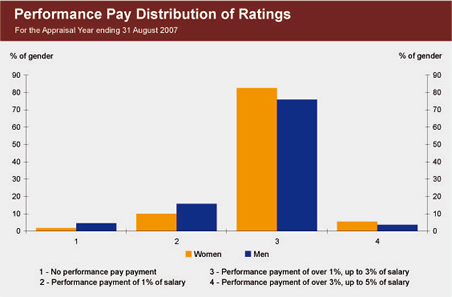
Section 3.5: Turnover
The RBA continues to monitor separation data to identify any trends in particular groups. There were 117 separations in 2007/08, compared with 100 the previous year. Women represented 33 per cent of all staff separations in this reporting period which is below their share of employment at the RBA of 42 per cent. The separation rates for women and staff born overseas from a non-English speaking background were both just under 10 per cent, below the separation rate of 13 per cent for the RBA as a whole.
The likelihood of staff staying with the RBA to retirement age is of interest to the RBA from a planning perspective. Staff eligible for retirement (or over 54 years of age) have the largest exit rate within the RBA, with one-quarter of these staff leaving during 2007/08; they account for just under 20 per cent of all exits. The majority of staff leaving the RBA, however, do so before the age of 35 (at 57 per cent of total exits), although this represents only 15 per cent of staff in these age groups. Around 11 per cent of graduates left the RBA in 2007/08 (or ten graduates), which is slightly lower than that observed in the finance sector more generally (which has a graduate turnover rate of 16 per cent). The large majority of graduates resigning were male, while the average length of employment for graduates that left the RBA in 2007/08 was 1½ years.
